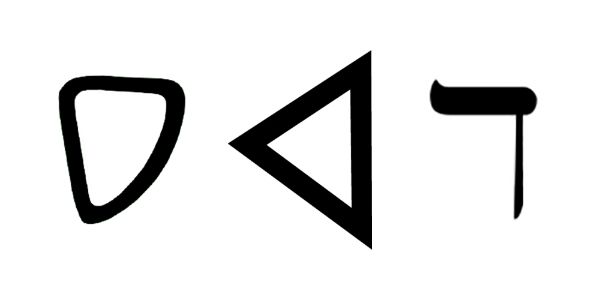The word habal (𐤄𐤁𐤋) or “Abel” is associated with two meanings. The first meaning is that of “vain” which means excessively proud of or concerned about one’s own appearance, qualities, and achievements; conceited. The last association of the word is the second 𐤁𐤍 (ban) of 𐤀𐤃𐤌 (Adam) and 𐤇𐤅𐤄 (Khauah) / 𐤇𐤉𐤄 (Khayah).
He is the younger 𐤀𐤇 (akh) of 𐤒𐤉𐤍 (Qayan). His name has also been written as Habel in the modern Masoretic Hebrew or Yiddish translations. His name could also be interpreted as a combination of 𐤄 (Ha) and 𐤁𐤋 (Bal) meaning The Bal or The Master or The Lord.
The Paleo-Hebrew language or the original language of the Ābarayam is one spoken with an emphasis on the rauakh (breath, wind, spirit). With the language of the Ābarayam, each letter has a meaning and a number associated with it that adds meaning to each word they’re used with. Below you will be able to learn more about the letter in Ancient Hebrew, Yiddish Hebrew, Greek, and much more.
Letter Meanings
| Letter | Meaning |
|---|---|
| 𐤄 (h) – ha | look, behold, the, reveal, breath, life, man Prefix: the, this |
| 𐤁 (b) – ba | House, family, “in” |
| 𐤋 (l) – la | staff, goad, control, toward, protect, authority, bind, yoke, lead Suffix: Forms diminutive (abbreviated) nouns when added to a noun. Suffix: Forms fractional numerals when added to the stem of an ordinal numeral. |
| Ābarayat Number | |
| Hebrew Gematria | |
| English Gematria | |
| Simple Gematria |
Based on the meaning of the letters the word could be defined as:
- “behold family of authority (power)”
- “behold house of protection”
- “behold house of control”
- “breath (life) of family of authority (power)”
- Combines Ha- and Bal
- “The Master”
- “The Lord”
- “The House of Authority (power)”
Definitions for 𐤄𐤁𐤋 / habal
| Language | Word | Transliteration | Pronunciation | Definition |
|---|---|---|---|---|
| Ābarayat | 𐤄𐤁𐤋 | habal | ha-bal’ | to act emptily, become vain. |
| English | Abel | Abel | ey-buhl | the second son of Adam and Eve, slain by his brother, Cain. Genesis 4. |
| Hebrew | הָבַל | habal hebel habel | haw-bal’ heh’bel heh’-bel | to act emptily, become vain. |
| Arabic | هابيل بخار | habil bukar | haw-bel b-oo-kahr | the second son of Adam, Abel. |
| Greek | ἀτμίς Ἄβελ | atmis Habel | at-mece’ ab’-el | breath, steam, vapor. |
In The Beginning
According to the fourth chapter of 𐤁𐤓𐤀𐤔𐤉𐤕 (BaRaashayat), 𐤒𐤉𐤍 (Qayan) and Habal are the first two 𐤁𐤍𐤉𐤌 (banayam) of 𐤀𐤃𐤌 (Adam) and 𐤇𐤅𐤄 (Khauah) / 𐤇𐤉𐤄 (Khayah). 𐤒𐤉𐤍 (Qayan), the 𐤁𐤊𐤅𐤓 (bakauar) and his 𐤀𐤇 (akh), was a 𐤀𐤊𐤓 (akar), and he was a 𐤓𐤅𐤉 (rauay). The 𐤀𐤇𐤉𐤌 (akhayam) made sacrifices to 𐤉𐤄𐤅𐤄 (Yahauah) / 𐤉𐤄𐤉𐤄 (Yahayah), each of his own produce, but 𐤉𐤄𐤅𐤄 (Yahauah) / 𐤉𐤄𐤉𐤄 (Yahayah) approved of his sacrifice instead of 𐤒𐤉𐤍 (Qayan)’s sacrifice. His 𐤀𐤇 (akh) then murdered him out of anger.
There are five prevalent interpretations for why his sacrifice was accepted over his brother. However, no real reason is provided by the scriptures and we can only test each interpretation for how likely they are. The five main interpretations are:
- The Pure of Heart
𐤄𐤁𐤋 (Habal) made his offering to the Most High with a pure heart and thus his sacrifice was seen as pure. Compared to his 𐤀𐤇 (akh) who made it begrudgingly and thus was not accepted. This stance is endorsed by the Christian Church to support the idea that as long as your heart is in the right place then you are fine. However, this could be likely for the reasoning of the offering acceptance based on other scriptures but it may not be the case since the intentions of the heart are not in reference to offerings in the scriptures. - The First Fruits
He made an offering of the first fruits [the 𐤁𐤊𐤅𐤓 (bakauar) animals] compared to his 𐤀𐤇 (akh) who kept his first fruits for himself and gave from the remaining. This is likely since there are further scriptures that talk about giving your first fruits as an offering. - Meat vs Plants
This theory claims that the Most High supports meat-eating and only wants to have meat sacrificed unto him. This would be why the animals of 𐤄𐤁𐤋 (Habal) were accepted but the crops of 𐤒𐤉𐤍 (Qayan) were not. However, this is unlikely since there are future scriptures that discuss and support the offering of crops to the Most High as well as scriptures where He says He’s tired of our meat offerings. - The Serpent Seed
That the two 𐤀𐤇 (akh) were heteropaternal superfecundation twins and 𐤒𐤉𐤍 (Qayan) was born of the 𐤍𐤇𐤔 (nakhash) and 𐤄𐤁𐤋 (Habal) was born of 𐤀𐤃𐤌 (Adam). This is not impossible, however, it is highly unlikely since this would mean the fruits of the 𐤏𐤑 (āts) were sex but based on 𐤏𐤁𐤓𐤉 (Ābaray) scriptures the fruit of the 𐤏𐤑 (āts) 𐤃𐤏𐤕 (daāt) 𐤈𐤅𐤁 (thauab) 𐤓𐤏 (raā) is divination, enchantments, or witchcraft. Also, the Book of 𐤉𐤅𐤁𐤋 (Yauabal) says “And in the third week in the second jubilee she gave birth to Cain, and in the fourth she gave birth to Abel, and in the fifth she gave birth to her daughter Âwân. And in the first (year) of the third jubilee, *Cain slew Abel because (God) accepted the sacrifice of Abel, and did not accept the offering of Cain.” This places them more than nine months from the expulsion from the garden for birth to occur. - The Sacrifice for Marriage
That their 𐤀𐤁 (ab) married him to his 𐤀𐤇 (akh)’s twin 𐤋𐤋𐤀𐤄 (Lalaah) and 𐤒𐤉𐤍 (Qayan) was married to 𐤄𐤁𐤋 (Habal)‘s twin 𐤏𐤑𐤓𐤄 (Ātsarah). 𐤒𐤉𐤍 (Qayan) preferred his own twin 𐤀𐤇𐤅𐤕 (akhauat) but she was married to his 𐤀𐤇 (akh). Thus, their 𐤀𐤁 (ab) told them to make a sacrifice to the Most High and the one who was approved would be married to her. The Most High chose to not have two twins married and approved of 𐤄𐤁𐤋 (Habal)‘s sacrifice. This is supported by the Forgotten Books Of Eden as well as Islamic and Rabbinic traditions but has no additional scriptures to support this theory.
Jewish and Christian Interpretations
According to the Coptic Book of 𐤀𐤃𐤌 (Adam) and 𐤇𐤅𐤄 (Khauah) / 𐤇𐤉𐤄 (Khayah), and the Syriac Cave of Treasures, his body, after many days of mourning,+ was placed in the Cave of Treasures, before which 𐤀𐤃𐤌 (Adam) and 𐤇𐤅𐤄 (Khauah) / 𐤇𐤉𐤄 (Khayah), and their descendants, offered their prayers. In addition, the 𐤔𐤕𐤉 (Shatay) line of the Generations of 𐤀𐤃𐤌 (Adam) swears by 𐤄𐤁𐤋 (Habal)‘s blood to segregate themselves from the unrighteous.
In the Book of 𐤇𐤍𐤅𐤊 (Khanauak), his soul is described as having been appointed as the chief of martyrs, crying for vengeance, for the destruction of the seed of 𐤒𐤉𐤍 (Qayan). This view is later repeated in the Testament of 𐤀𐤁𐤓𐤄𐤌 (Abaraham), where 𐤄𐤁𐤋 (Habal) has been raised to the position as the judge of the souls.
Islamic Interpretations
According to Shi’a Muslim belief, “Abel” (“Habeel”) is buried in the Nabi Habeel Mosque, located in the west mountains of Damascus, near the Zabadani Valley, overlooking the villages of the Barada river (Wadi Barada), in Syria. Shi’a are frequent visitors of this mosque for ziyarat. The mosque was built by Ottoman Wali Ahmad Pasha in 1599.
Genealogy
Images for 𐤄𐤁𐤋 / habal


Maps for 𐤄𐤁𐤋 / habal

Definitions for /
When adding the 𐤉 (yad) to the end of a word, it creates a possessive of the original word. It can either signify “my…” or identify a member of a nation. For example, 𐤏𐤁𐤓 (Ābar) is the progenitor, but 𐤏𐤁𐤓𐤉 (Ābaray) is the singular descendant of him also known as a Hebrew.
| Language | Word | Transliteration | Pronunciation | Definition |
|---|---|---|---|---|
| Ābarayat | ||||
| English | ||||
| Hebrew | ||||
| Arabic | ||||
| Greek |
Images for /


Definitions for /
When adding the 𐤌 (mayam) after the 𐤉 (yad) to the end of a word, it creates a plural of the original word. It can identify multiple members of a nation. For example, 𐤏𐤁𐤓 (Ābar) is the progenitor, but 𐤏𐤁𐤓𐤉𐤌 (Ābarayam) are the plural descendants of him also known as Hebrews.
| Language | Word | Transliteration | Pronunciation | Definition |
|---|---|---|---|---|
| Ābarayat | ||||
| English | ||||
| Hebrew | ||||
| Arabic | ||||
| Greek |
Images for /


Definitions for /
When adding the 𐤕 (tau) after the 𐤉 (yad) to the end of a word, it creates a plural of the original word. It identifies the language or a sign of a nation’s existence. For example, 𐤏𐤁𐤓 (Ābar) is the progenitor, but 𐤏𐤁𐤓𐤉𐤕 (Ābarayat) is the language of him also known as Paleo-Hebrew language.
| Language | Word | Transliteration | Pronunciation | Definition |
|---|---|---|---|---|
| Ābarayat | ||||
| English | ||||
| Hebrew | ||||
| Arabic | ||||
| Greek |
Images for /
| Character | Name | Transliteration | Pronunciation |
|---|---|---|---|
Classification
You can continue your studies of the words by viewing Strong’s entries for:



